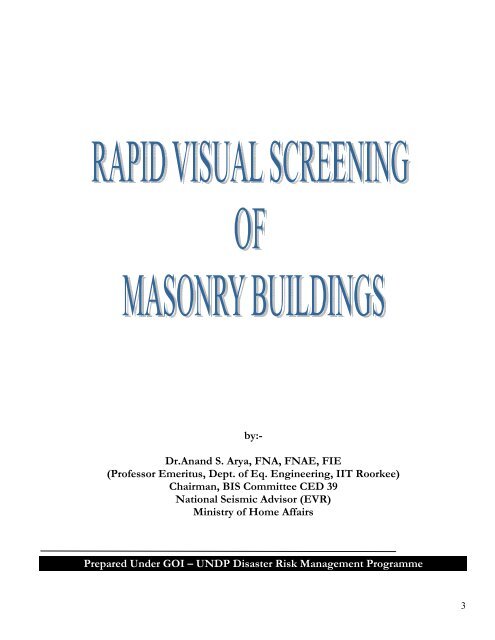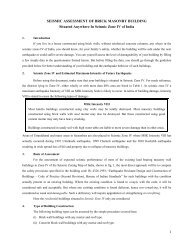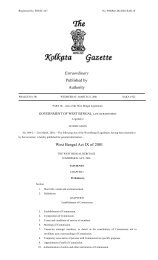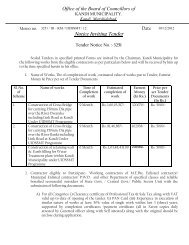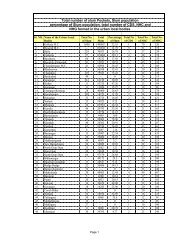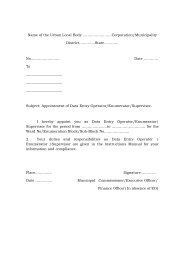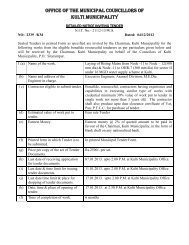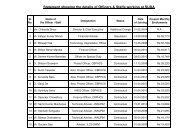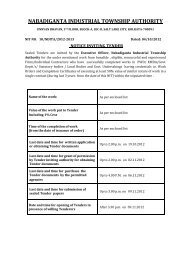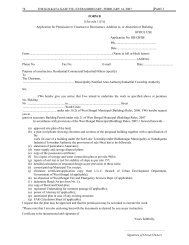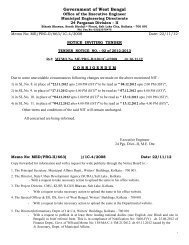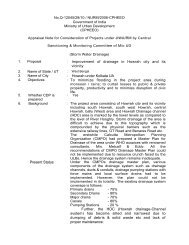Rapid visual screening of masonry buildings - NIDM
Rapid visual screening of masonry buildings - NIDM
Rapid visual screening of masonry buildings - NIDM
Create successful ePaper yourself
Turn your PDF publications into a flip-book with our unique Google optimized e-Paper software.
<strong>Rapid</strong> Visual Screening <strong>of</strong> Masonry BuildingsA.1 RVS Procedure, Objectives and ScopeThe <strong>Rapid</strong> Visual Screening method is designed to be implemented without performing anystructural calculations. The procedure utilises a damageability grading system that requires theevaluator to (1) identify the primary structural lateral load-resisting system, and (2) identify buildingattributes that modify the seismic performance expected for this lateral load-resisting system alongwith non-structural components. The inspection, data collection and decision-making processtypically occurs at the building site, and is expected to take couple <strong>of</strong> hours for a building,depending on its size.The <strong>screening</strong> is based on Code based Seismic Intensity, Building Type and Damageability Gradeas observed in past earthquake and covered in MSK/European macro-intensityA.2 Uses <strong>of</strong> RVS ResultsThe main uses <strong>of</strong> this procedure in relation to seismic upgrading <strong>of</strong> existing <strong>buildings</strong> are:i. To identify if a particular building requires further evaluation for assessment <strong>of</strong> its seismicvulnerability.ii. To assess the seismic damageability (structural vulnerability) <strong>of</strong> the building and seismicrehabilitation needs.iii. To identify simplified retr<strong>of</strong>itting requirements for the building (to collapse prevention level)where further evaluations are not considered necessary or not found feasible.A.3 Seismic Hazard in IndiaAs per IS 1893:2002 (Part 1), India has been divided into 4 seismic hazard zones (seeFig.A.1). The details <strong>of</strong> different seismic zones are given below:Zone II Low seismic hazard (damage during earthquake may be <strong>of</strong> MSK Intensity VIor lower)Zone III Moderate seismic hazard (maximum damage during earthquake may be uptoMSK Intensity VII)Zone IV High seismic hazard (maximum damage during earthquake may be upto MSKIntensity VIII)Zone V Very high seismic hazard (maximum damage during earthquake may be <strong>of</strong>MSK Intensity IX or greater)When a particular damage Intensity occurs, different building types experience different levels <strong>of</strong>damage depending on their inherent characteristics. For carrying out the <strong>Rapid</strong> Visual Screening,all four hazard zones have been considered.A.4 Building Types Considered in RVS Procedure4
A wide variety <strong>of</strong> construction types and building materials are used in urban and rural areas<strong>of</strong> India. These include local materials such as mud, straw and wood, semi-engineered materialssuch as burnt brick and stone <strong>masonry</strong> and engineered materials such as concrete and steel. Theseismic vulnerability <strong>of</strong> the different building types depends on the choice <strong>of</strong> building materials andconstruction technology adopted. The building vulnerability is generally highest with the use <strong>of</strong>local materials without engineering inputs and lowest with the use <strong>of</strong> engineered materials andskills.The basic vulnerability class <strong>of</strong> a building type is based on the average expected seismicperformance for that building type. All <strong>buildings</strong> have been divided into type A to type F based onthe European Macroseismic Scale (EMS-98) recommendations. The <strong>buildings</strong> in type A have thehighest seismic vulnerability while the <strong>buildings</strong> in type F have the lowest seismic vulnerability. Abuilding <strong>of</strong> a given type, however, may have its vulnerability different from the basic class definedfor that type depending on the condition <strong>of</strong> the building, presence <strong>of</strong> earthquake resistancefeatures, architectural features, number <strong>of</strong> storeys etc. It is therefore possible to have adamageability range for each building type considering the different factors affecting its likelyperformance. Some variations in building type are therefore defined as A, B, B+ etc.The RVS procedure presented here has considered different building types, based on the buildingmaterials and construction types that are most commonly found in India. Masonry <strong>buildings</strong> arepresented in Tables A.1. The likely damages to <strong>buildings</strong> have been categorized in differentGrades depending on the seismic impact on the strength <strong>of</strong> the building.A.5 Grades <strong>of</strong> Damageability`Five grades <strong>of</strong> damageability from G1 to G5 are specified in MSK and European IntensityScale as described in Table A.2:A.6 Relationship <strong>of</strong> Seismic Intensity, Building Type & Damage GradesTable A.3 provides guidance regarding likely performance <strong>of</strong> the building in the event <strong>of</strong>design-level earthquake intensity postulated in the seismic zone. This information has been usedin the survey forms to decide if there is necessity <strong>of</strong> further evaluation <strong>of</strong> the building using higherlevel procedures. It can also be used to identify need for retr<strong>of</strong>itting, and to recommend simpleretr<strong>of</strong>itting techniques for ordinary <strong>buildings</strong> where more detailed evaluation is not feasible.The Indicative quantities Few, Many and Most as defined in European Intensity Scales are asfollows:Few: Less than (15±5) %; Many: Between (15±5) to (55±5) %;Most: Between (55±5) to100%As per MSK Intensity scale the average values <strong>of</strong> these terms may be taken asFew: 5-15% Many: 50% Most: 75%Table A.3 is generally based on MSK descriptions.A.7 RVS Survey Forms – Special Points5
The RVS survey forms are developed here for all the seismic zones II to V based on theprobable earthquake Intensities, building types and damageability grades as described above.Some special cases included therein are described below:1) Importance <strong>of</strong> Building/StructureAs per IS: 1893-2002, an important factor I is defined for enhancing the seismic strength <strong>of</strong><strong>buildings</strong> & structures, as follows:Important <strong>buildings</strong>*: Hospitals, Schools, monumental structures; emergency <strong>buildings</strong> liketelephone exchange, television, radio stations, railway stations, fire stations, large communityhalls like cinemas, assembly halls and subway stations, power stations, Important Industrialestablishments, VIP residences & Residences <strong>of</strong> Important Emergency person.*Any building having more than 100 Occupants may be treated as Important for purpose <strong>of</strong>RVS.For these important <strong>buildings</strong> the value <strong>of</strong> I is specified as 1.5, by which the design seismicforce is increased by a factor <strong>of</strong> 1.5. Now the seismic zone factors for zone II to V are asfollows.Zone II III IV VZone Factor 0.10 0.16 0.24 0.36It is seen that one Unit change in Seismic Zone Intensity increases the Zone Factor 1.5 times.Hence to deal with the damageability <strong>of</strong> important <strong>buildings</strong> in any zone, they should bechecked for one Unit higher zone. The assessment forms are designed accordingly.2) Special HazardsThere are some special hazardous conditions to be considered:I. Liquefiable condition: Normal loose sands submerged under high water table aresusceptible to liquefaction under moderate to high ground accelerations; building foundedon such soils will require special evaluation and treatment.II. Land Slide Prone Area: If the building is situated on a hill slope which is prone to land slide/land slip or rock-fall under monsoon and/or earthquake, special geological & geotechnicalevaluation <strong>of</strong> the site and treatment <strong>of</strong> the building will be needed.III. Irregular Buildings:Irregularities in <strong>buildings</strong> are defined in Cl.7.1 <strong>of</strong> IS: 1893 – 2002 under the following subheads:i. Plan Irregularities: These are defined in Table 4 <strong>of</strong> the Code as follows:a) Torsion Irregularityb) Re-entrant Cornersc) Diaphragm Discontinuityd) Out <strong>of</strong> Plane Offsetse) Non – Parallel SystemsThe Geometric Irregularities in building plans which can be easily identified are shown inFig.A.26
These irregularities enhance the overall damage (increased grade <strong>of</strong> damage e.g. at reentrantcorners). Such a building may be recommended for detailed evaluation.ii. Vertical Irregularities: The following vertical irregularities may be seen in <strong>masonry</strong><strong>buildings</strong> (see Fig. A.3).a) Mass Irregularityb) Vertical Geometric Irregularityc) In-Plane Discontinuity in vertical Elements Resisting Lateral Forces.If any <strong>of</strong> these irregularities are noticed, the building should be recommended for detailedevaluation.IV. Falling Hazard: Where such hazards are present, particularly in Zones IV & V,recommendations should make reference to these in the survey report as indicated.V. Type <strong>of</strong> Foundation Soil: IS 1893-2002 defines three soil types hard/stiff, medium & s<strong>of</strong>t.No effect <strong>of</strong> these is seen in the design spectra <strong>of</strong> short period <strong>buildings</strong>, T< 0.4 second,covering all <strong>masonry</strong> <strong>buildings</strong>, hence the effect may be considered not so significant.Table A.1: Masonry load bearing wall <strong>buildings</strong>BuildingDescriptionTypeAa) Rubble (Field stone) in mud mortar or without mortar usually with slopingwooden ro<strong>of</strong>.b) Uncoursed rubble <strong>masonry</strong> without adequate ‘through stones’.c) Masonry with round stones.BSemi-dressed, rubble, brought to courses, with through stones and longcorner stones; unreinforced brick walls with country type wooden ro<strong>of</strong>s;unreinforced CC block walls constructed in mud mortar or weak limemortar.B+ a) Unreinforced brick <strong>masonry</strong> in mud mortar with vertical wood posts orhorizontal wood elements or seismic band (IS: 13828)b) Unreinforced brick <strong>masonry</strong> in lime mortar.Ca) Unreinforced <strong>masonry</strong> walls built from fully dressed (Ashler) stone<strong>masonry</strong> or CC block or burnt brick using good cement mortar, eitherhaving RC floor/ro<strong>of</strong> or sloping ro<strong>of</strong> having eave level horizontal bracingsystem or seismic band.b) As at B with horizontal seismic bands (IS: 13828)C+ Like C(a) type but having horizontal seismic bands at lintel level <strong>of</strong> doors &windows (IS: 4326)D Masonry construction as at C(a) but reinforced with bands & verticalreinforcement, etc (IS: 4326), or confined <strong>masonry</strong> using horizontal & verticalreinforcing <strong>of</strong> walls.Table A.2: Grades <strong>of</strong> Damageability <strong>of</strong> Masonry Buildings7
Classification <strong>of</strong> damage to <strong>masonry</strong> <strong>buildings</strong>Grade 1: Negligible to slight damage (no structural damage, slight non-structuraldamage)Structural: Hair-line cracks in very few walls.Non-structural: Fall <strong>of</strong> small pieces <strong>of</strong> plaster only.Fall <strong>of</strong> loose stones from upper parts <strong>of</strong> <strong>buildings</strong> in very few cases.Grade 2: Moderate damage (Slight structural damage, moderate non-structural damage)Structural: Cracks in many walls, thin cracks in RC* slabs and A.C.* sheets.Non-structural: Fall <strong>of</strong> fairly large pieces <strong>of</strong> plaster, partial collapse <strong>of</strong> smoke chimneys onro<strong>of</strong>s. Damage to parapets, chajjas. Ro<strong>of</strong> tiles disturbed in about 10% <strong>of</strong> thearea. Minor damage in under structure <strong>of</strong> sloping ro<strong>of</strong>s.Grade 3: Substantial to heavy damage (moderate structural damage, heavy nonstructuraldamage)Structural:Non-structural:Large and extensive cracks in most walls. Wide spread cracking <strong>of</strong> columnsand piers.Ro<strong>of</strong> tiles detach. Chimneys fracture at the ro<strong>of</strong> line; failure <strong>of</strong> individual non-structural elements (partitions, gable walls).Grade 4: Very heavy damage (heavy structural damage, very heavy non-structuraldamage)Structural: Serious failure <strong>of</strong> walls (gaps in walls), inner walls collapse; partial structuralfailure <strong>of</strong> ro<strong>of</strong>s and floors.Grade 5: Destruction (very heavy structural damage)Total or near total collapse <strong>of</strong> the building.* RC = Reinforced Concrete; AC = Asbestos CementTable A.3: Damageability Grades <strong>of</strong> Masonry Buildings8
MASONRYBUILDINGSType <strong>of</strong>BuildingZone IIMSK VI or lessA Many <strong>of</strong> grade 1Few <strong>of</strong> grade 2(rest nodamage)BandB+CandC+Many <strong>of</strong> grade 1Few <strong>of</strong> grade 2(rest nodamage)Few <strong>of</strong> grade 1(rest nodamage)Zone IIIMSK VIIMost <strong>of</strong> grade 3Few <strong>of</strong> grade 4(rest <strong>of</strong>grade2or1)Many <strong>of</strong> grade 2Few <strong>of</strong> grade 3(rest <strong>of</strong> grade 1)Many <strong>of</strong> grade 1Few <strong>of</strong> grade 2(rest <strong>of</strong> grade1,0)Zone IVMSK VIIIMost <strong>of</strong> grade4Few <strong>of</strong> grade 5(rest <strong>of</strong> grade3,2)Most <strong>of</strong> grade3Few <strong>of</strong> grade 4(rest <strong>of</strong> grade2)Most <strong>of</strong> grade2Few <strong>of</strong> grade 3(rest <strong>of</strong> grade1)Zone VMSK IX orMoreMany <strong>of</strong> grade 5(rest <strong>of</strong> grade4&3)Many <strong>of</strong> grade 4Few <strong>of</strong> grade 5(rest <strong>of</strong> grade 3)Many <strong>of</strong> grade 3Few <strong>of</strong> grade 4(rest <strong>of</strong> grade 2)D Few <strong>of</strong> grade 1 Few <strong>of</strong> grade 2 Many <strong>of</strong> grade 2Few <strong>of</strong> grade 3(rest <strong>of</strong> grade 1)NOTE:1. As per MSK scale, few, Many and Most may be taken as: Few: 15%, Many: 50% andMost: 75%.2. Buildings having vertical irregularity may under go severe damage in seismic zones III,IV & V if not specifically designed. Hence they will require special evaluation. Also<strong>buildings</strong> sited in liquefiable or landslide prone areas will require special evaluation forseismic safety.3. Buildings having plan irregularity may under go a damage <strong>of</strong> one grade higher in zonesIII, IV & V. The surveyor may recommend re-evaluation.9
ZONE V MM IX OR MOREZONE IV MM VIIIZONE III MM VIIZONE II MM VI OR LESSAREAS UNDER THE ZONESV 10.8 %IV 17.5 %III 30.8 %TOTAL DAMAGEABLE AREA~ 59 %Fig. A.1 EARTHQUAKE HAZARD ZONES 200210
FIG. A.2:- HORIZONTAL IRREGULARITIESFIG. A.3:- VERTICAL IRREGULARITIES11
1 <strong>Rapid</strong> Visual Screening <strong>of</strong> Masonry Buildings for Seismic HazardsSeismic Zone II Ordinary Building1.1 Building Name_____________________________________1.2 Use______________________________________________1.3 Address:__________________________________________________________________Pin ______________1.4 Other Identifiers____________________________________Photograph1.5 No. <strong>of</strong> Stories____________ 1.6 Year Built _____________1.7 Total Covered Area; all floors (sq.m) ___________________1.8 Ground Coverage (Sq.m):____________________________1.9 Soil Type:__________1.10 Foundation Type:_____________1.11 Ro<strong>of</strong> Type:______________ 1.12 Floor Type____________1.12 Structural Components:1.12.1 Wall Type: BB* Earthen UCR* CCB*1.12.2 Thickness <strong>of</strong> wall:_______ 1.12.3 Slab Thickness:______1.12.4 Mortar Type: Mud Lime Cement1.12.5 Vert. R/F bars: Corners T-junctions Jambs1.12.6 Seismic bands: Plinth Lintel Eaves GableSketch Plan with Length & Breadth2.0 OCCUPANCY 3.0 SPECIAL HAZARD2.1 Important <strong>buildings</strong>:Hospitals, Schools, monumentalstructures; emergency <strong>buildings</strong>like telephone exchange,television, radio stations, railwaystations, fire stations, largecommunity halls like cinemas,assembly halls and subwaystations, power stations, ImportantIndustrial establishments, VIPresidences & Residences <strong>of</strong>Important Emergency person.*Any building having morethan 100 Occupants may betreated as Important.2.2 Ordinary <strong>buildings</strong>:- Other<strong>buildings</strong> having occupants
2 <strong>Rapid</strong> Visual Screening <strong>of</strong> Masonry Buildings for Seismic HazardsSeismic Zone III Ordinary Building(Also for Zone II Important Building)Photograph1.1 Building Name_____________________________________1.2 Use______________________________________________1.3 Address:__________________________________________________________________Pin ______________1.4 Other Identifiers____________________________________1.5 No. <strong>of</strong> Stories____________ 1.6 Year Built _____________1.7 Total Covered Area; all floors (sq.m) ___________________1.8 Ground Coverage (Sq.m):____________________________1.9 Soil Type:__________1.10 Foundation Type:_____________1.11 Ro<strong>of</strong> Type:______________ 1.12 Floor Type____________1.12 Structural Components:1.12.1 Wall Type: BB* Earthen UCR* CCB*1.12.2 Thickness <strong>of</strong> wall:_______ 1.12.3 Slab Thickness:______1.12.4 Mortar Type: Mud Lime Cement1.12.5 Vert. R/F bars: Corners T-junctions Jambs1.12.6 Seismic bands: Plinth Lintel Eaves GableSketch Plan with Length & Breadth2.0 OCCUPANCY 3.0 SPECIAL HAZARD2.1 Important <strong>buildings</strong>:Hospitals, Schools, monumentalstructures; emergency <strong>buildings</strong>like telephone exchange,television, radio stations, railwaystations, fire stations, largecommunity halls like cinemas,assembly halls and subwaystations, power stations, ImportantIndustrial establishments, VIPresidences & Residences <strong>of</strong>Important Emergency person.*Any building having morethan 100 Occupants may betreated as Important.2.2 Ordinary <strong>buildings</strong>:- Other<strong>buildings</strong> having occupants
3 <strong>Rapid</strong> Visual Screening <strong>of</strong> Masonry Buildings for Seismic HazardsSeismic Zone IV Ordinary Building(Also for Zone III Important Building)Photograph1.1 Building Name_____________________________________1.2 Use______________________________________________1.3 Address:__________________________________________________________________Pin ______________1.4 Other Identifiers____________________________________1.5 No. <strong>of</strong> Stories____________ 1.6 Year Built _____________1.7 Total Covered Area; all floors (sq.m) ___________________1.8 Ground Coverage (Sq.m):____________________________1.9 Soil Type:__________1.10 Foundation Type:_____________1.11 Ro<strong>of</strong> Type:______________ 1.12 Floor Type____________1.12 Structural Components:1.12.1 Wall Type: BB* Earthen UCR* CCB*1.12.2 Thickness <strong>of</strong> wall:_______ 1.12.3 Slab Thickness:______1.12.4 Mortar Type: Mud Lime CementSketch Plan with Length & Breadth2.0 OCCUPANCY 3.0 SPECIAL HAZARD2.1 Important <strong>buildings</strong>:Hospitals, Schools, monumentalstructures; emergency <strong>buildings</strong>like telephone exchange,television, radio stations, railwaystations, fire stations, largecommunity halls like cinemas,assembly halls and subwaystations, power stations, ImportantIndustrial establishments, VIPresidences & Residences <strong>of</strong>Important Emergency person.*Any building having morethan 100 Occupants may betreated as Important.2.2 Ordinary <strong>buildings</strong>:- Other<strong>buildings</strong> having occupants
4 <strong>Rapid</strong> Visual Screening <strong>of</strong> Masonry Buildings for Seismic HazardsSeismic Zone V All Buildings(Also for Zone IV Important Building)Photograph1.1 Building Name_____________________________________1.2 Use______________________________________________1.3 Address:__________________________________________________________________Pin ______________1.4 Other Identifiers____________________________________1.5 No. <strong>of</strong> Stories____________ 1.6 Year Built _____________1.7 Total Covered Area; all floors (sq.m) ___________________1.8 Ground Coverage (Sq.m):____________________________1.9 Soil Type: __________1.10 Foundation Type: ____________1.11 Ro<strong>of</strong> Type:______________ 1.12 Floor Type____________1.12 Structural Components:1.12.1 Wall Type: BB* Earthen UCR* CCB*1.12.2 Thickness <strong>of</strong> wall:_______ 1.12.3 Slab Thickness:______1.12.4 Mortar Type: Mud Lime Cement1.12.5 Vert. R/F bars: Corners T-junctions Jambs1.12.6 Seismic bands: Plinth Lintel Eaves GableSketch Plan with Length & Breadth2.0 OCCUPANCY 3.0 SPECIAL HAZARD2.1 Important <strong>buildings</strong>:Hospitals, Schools, monumentalstructures; emergency <strong>buildings</strong>like telephone exchange,television, radio stations, railwaystations, fire stations, largecommunity halls like cinemas,assembly halls and subwaystations, power stations, ImportantIndustrial establishments, VIPresidences & Residences <strong>of</strong>Important Emergency person.*Any building having morethan 100 Occupants may betreated as Important.2.2 Ordinary <strong>buildings</strong>:- Other<strong>buildings</strong> having occupants
Prepared by:Pr<strong>of</strong>essor Anand S. Arya and Ankush Agarwalunder the GoI-UNDP Disaster Risk Management ProgrammeEmail: anand.s.arya@undp.org, ankush.agarwal@undp.orgNATIONAL DISASTER MANAGEMENT DIVISIONMinistry <strong>of</strong> Home Affairs, North Block, New DelhiTel: 91-11-23093178; Tele/fax: 23094019, Email: ndmindia@nic.in; Website: www.ndmindia.nic.in37


